The 22nd Tokyo Tech Challenging Research Awards went to ten researchers each of whom will receive a research grant. The Suematsu Challenging Research Award was given to the three highest qualified researchers among the Challenging Research Award winners. The award ceremony was held on August 31.
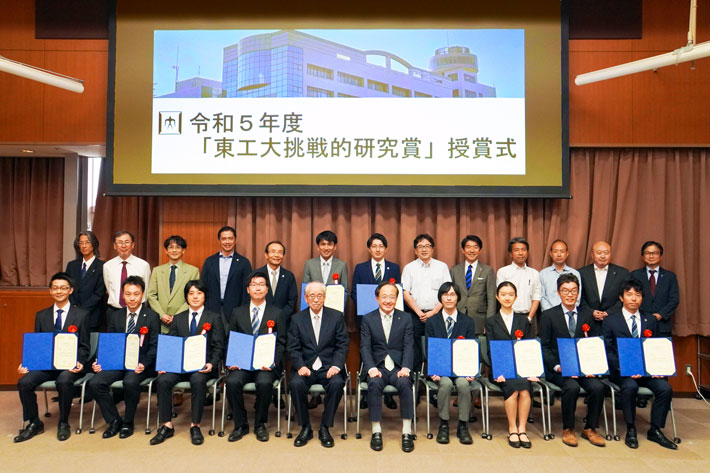
Commemorative photo of the ceremony
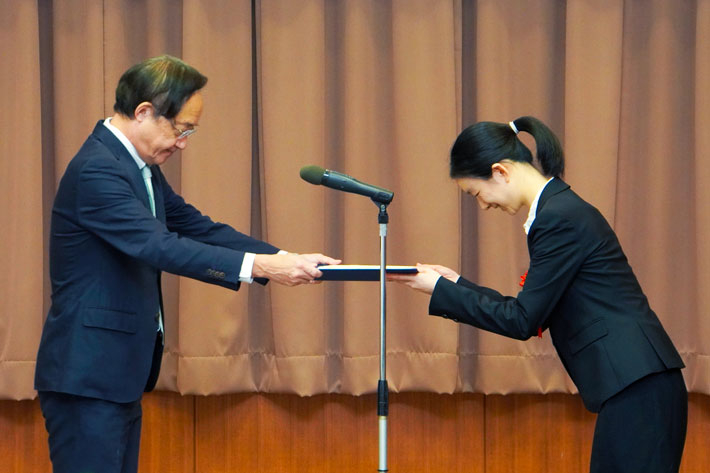
President Kazuya Masu (left) presenting the award to Asst. Prof. Youyou Cong
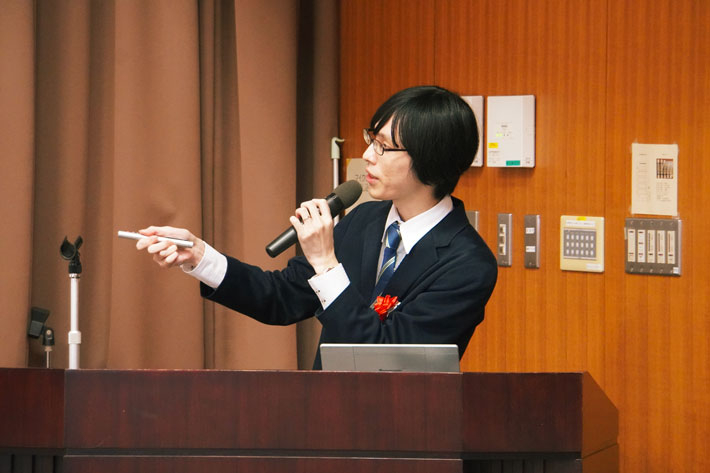
Asst. Prof. Yuki Nagashima, one of the awardees, delivered a presentation about his research topic.
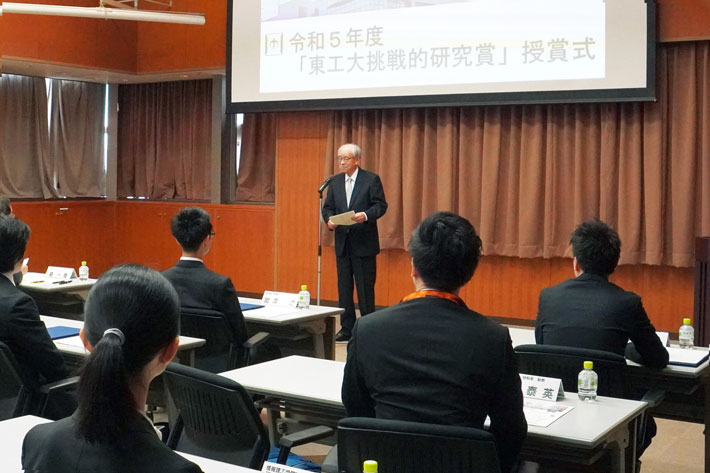
Honorary Professor Yasuharu Suematsu gave congratulatory remarks to winners.
The grant was established with the aim of encouraging young faculty members at the Institute to engage in challenging research. It recognizes creative, up-and-coming researchers who boldly pursue the promotion of the most advanced research in the world, pioneering of new fields of study, innovative development of new research, and important issues that are difficult to solve.
The Suematsu Challenging Research Award is given to the highest qualified researchers among the Challenging Research Award winners. This award was established by the “Suematsu Fund”, which was created based on the desire of former President Yasuharu Suematsu to support young researchers. When Professor Yasuharu Suematsu received the Japan Prize in 2014, he donated a portion of the prize money to Tokyo Tech, which established the Suematsu Fund to encourage young researchers. The Fund supports mainly young researchers to encourage their research activities to predict and study the development of unexplored scientific and technological systems in diverse fields and to bring the potential future to real society.
2023 Tokyo Tech Challenging Research Award recipients
Kazuyuki SEKIZAWA
Associate Professor, Department of Physics, School of Science
Developing a Microscopic Theory for Quantum Many-Body Tunneling
Jiang PU
Associate Professor, Department of Physics, School of Science
Transport and Optical Properties in 1D Moire Superlattice
Kazumi OZAKI
Associate Professor, Department of Earth and Planetary Sciences, School of Science
Identification of the tipping point for global ocean deoxygenation considering the P-S-Fe cycles
Yasuhide MOCHIZUKI
Assistant Professor, Department of Materials Science and Engineering, School of Materials and Chemical Technology
Elucidation of universal mechanism of phonon-induced negative thermal expansion
Yuki NAGASHIMA
Assistant Professor, Department of Chemical Science and Engineering, School of Materials and Chemical Technology
Development of Organic Photoreactions Based on Theoretical and Experimental Studies
Youyou CONG
Tenure Track Assistant Professor, Department of Mathmatical and Computing Science, School of Computing
Developing a Typed Programming Language for Ensuring Fuzzy Specification
Takashi KANAMORI
Assistant Professor, Department of Life Science and Technology, School of Life Science and Technology
Development of genome photo-oxidation method and understanding of epigenetics with oxidatively damaged bases
Satoshi OKADA
Associate Professor, Laboratory for Chemistry and Life Science, Institute of Innovative Research
Development of Magnetic Probes for Molecular Whole-Brain Neuroimaging
Seiichiro IZAWA
Associate Professor, Laboratory for Materials and Structures, Institute of Innovative Research
Blue Organic Light-Emitting Diode with Extremely Low Driving
Hiroki TAKASU
Associate Professor, Laboratory for Zero-Carbon Energy, Institute of Innovative Research
Development of next-generation solid oxide reversible cell using metal support
Comments from the Suematsu Challenging Research Award winners
Yuki NAGASHIMA
Assistant Professor, Department of Chemical Science and Engineering, School of Materials and Chemical Technology
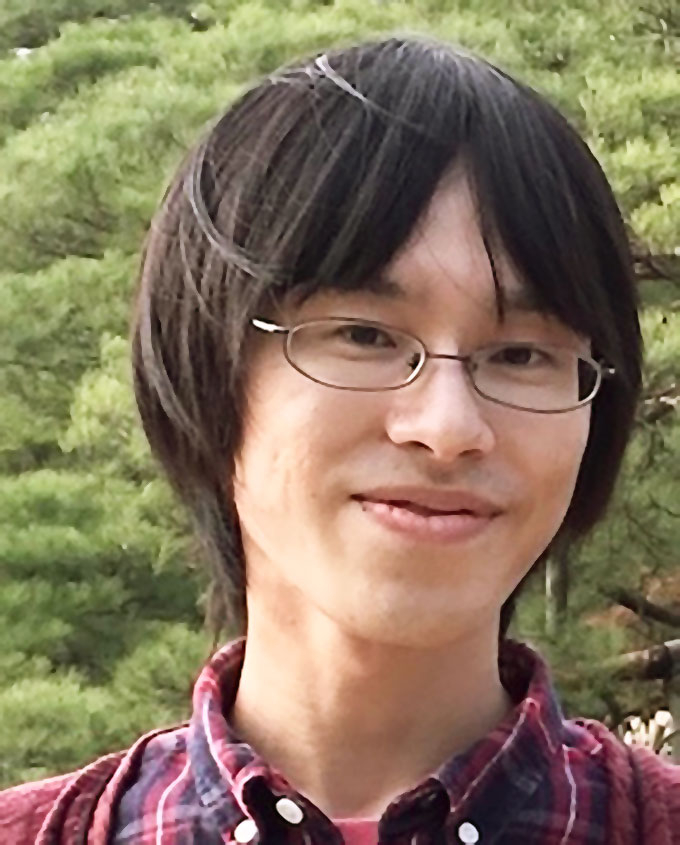
I am very honored to receive the prestigious Tokyo Tech Challenging Research Award and the Suematsu Challenging Research Award. I greatly appreciate the support of Professor Ken Tanaka, the many other professors and all of the project laboratory members.
Organic photoreactions use light energy to create photoexcited species, enabling molecular transformations that are difficult to achieve by conventional thermal reactions. In recent years, with the widespread use of LED lamps, we can conduct photoreactions by using simple equipment, and they have attracted attention as a new molecular conversion process. However, systematic designs are still a challenge, forcing chemists to rely on experience and trial and error, which has been a bottleneck in the development of diverse reactions. This study aims to overcome this difficulty and establish a new method for generating, controlling, and utilizing photoexcited species bearing diverse elements through integrated theoretical and experimental chemistry. This will expand the chemical space of diverse organic compounds that have been difficult to access in the past.
School of Materials and Chemical Technology
—Encompassing the Disciplines of Science—
Information on School of Materials and Chemical Technology inaugurated in April 2016
Satoshi OKADA
Associate Professor, Laboratory for Chemistry and Life Science, Institute of Innovative Research
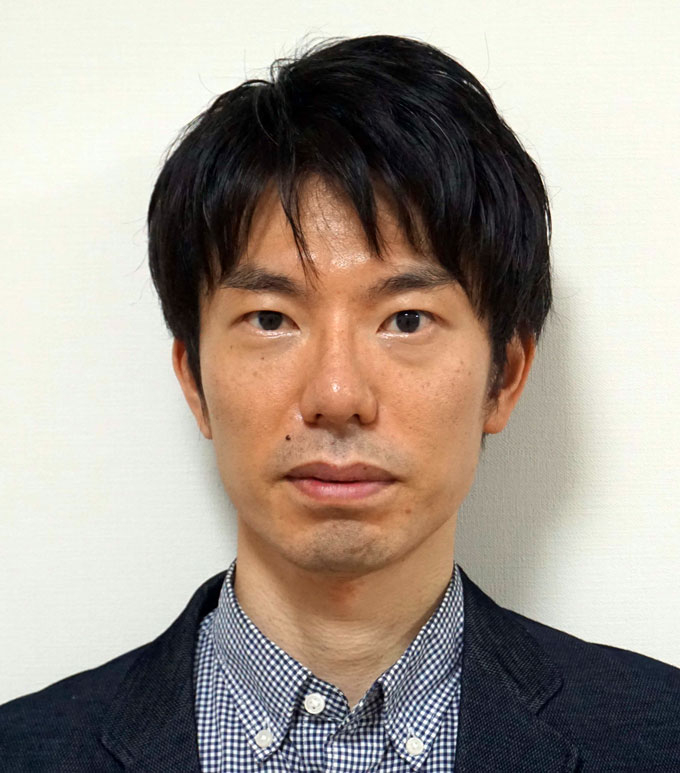
I am very honored to receive the prestigious Tokyo Tech Challenging Research Award and the Suematsu Challenging Research Award. I sincerely appreciate the tremendous support from Professor Hiroyuki Nakamura, assistant professors, staffs and students in our laboratory, and collaborators.
The brain function, which shapes our minds and behaviors, is highly integrated by neural circuits consisting of 100 billion neurons. While the brain controls signal transductions by utilizing various neurotransmitters released from neurons, it is known that the identical neurotransmitter can exhibit entirely different functions depending on the neural circuits. To understand the brain function, it is therefore necessary not only to observe the activities of individual neurons but also to observe the dynamics of neurotransmitters throughout the entire brain, where neural circuits are formed. This research aims to develop a neuroimaging technique that visualizes the dynamics of neurotransmitters at the whole-brain level by utilizing MRI contrast agents as molecular probes, that are designed to change MRI contrast in response to specific neurotransmitters.
Seiichiro IZAWA
Associate Professor, Laboratory for Materials and Structures, Institute of Innovative Research
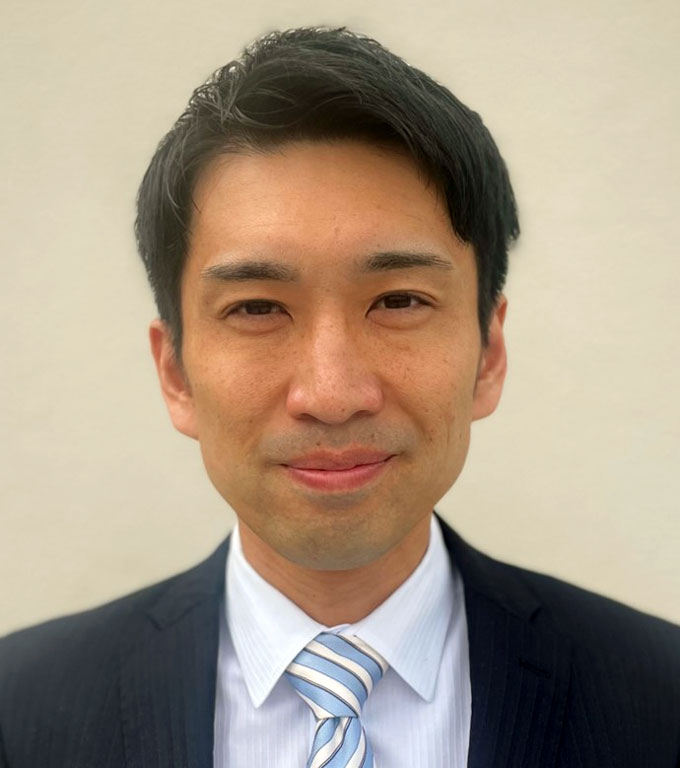
I am very honored to receive the Tokyo Tech Challenging Research Award and the Suematsu Challenging Research Award. I would like to express my sincere gratitude to all the people who have been involved in the research.
My research topic is organic optoelectronics devices such as organic light-emitting diode (OLED) and organic solar cell (OSC) using organic semiconductor materials. OLED is already used in our daily lives, such as TVs and smartphone displays. However, OLED has a problem that a large voltage is required to emit blue light. In this research, we aim to drastically reduce the voltage required to emit blue light from an OLED by using a upconversion process that I discovered recently. As a result, I would like to develop energy-saving OLED. This research was inspired by the photoelectric conversion mechanism of OSC, which I had originally studied. I would like to continue to exchange ideas with people in various fields and further develop my research.








